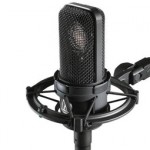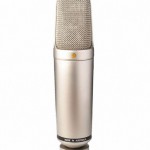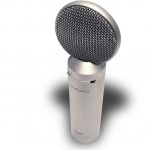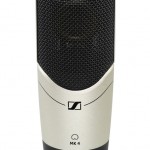Project Studio Toolbox: The Best Large Diaphragm Condenser Mics for $300
I started working as an audio engineer just as the home studio market began to blossom into what it is today.
This means that throughout my career, I’ve been as much of a counselor as a craftsperson, because so many of my clients spend nearly as much time recording at home as they do working with me in conventional studios.
I get calls every week for help with everything from key commands to console routing, but out of all the advice I’m asked for, the number one question might be: “I’m just starting to record at home. I have X dollars to spend and want a Y-style microphone. Which one should I buy?”
Category #1: The $300 Condenser
One of the most common requests from musicians just beginning to self record is for a recommendation of an entry level large-diaphragm condenser, at price of about $300.
I’m not sure why this is such a popular request, and my first instinct is usually to ask why they’re so sure they want an LDC, and why at that price.
For about the same amount, some of the best dynamic mics ever made are viable choices for many voices and instruments. And for just a bit more, there are a slew of small and large diaphragm condensers that would be a welcome addition to any commercial studio.
But that’s a topic for a whole separate article. The question of the $300 condenser comes up a lot, and it deserves a straight answer. It’s true that a home recordist with an inexpensive dynamic mic, an affordable condenser, and a halfway decent interface can cover a lot of ground – given patience, taste, some kickass music and maybe just a little bit of help now and then.
Here are few of the low-priced condensers I’ve encountered several times without developing the urge to throw them out a window.
Audio-Technica 4040 ($300 Street)
In the early 90s, Audio-Technica helped revolutionize the microphone market forever by introducing the AT4033. At the time, it was one of a small handful of reliable LDC microphones available for under $1,000.
Since then, the company has improved its designs, releasing now-classic affordable workhorse LDCs like the AT4050 [enter to win one here!], 4060 and 4047. Like many other manufacturers, they’ve gotten better at making mics cheaper too, and have had some great success with the AT4040.
While the 4040 resembles a single-pattern version of the more expensive 4050, it has a sound of its own. On paper, the 4040 has a bit more of an upper midrange “push” than the 4050,with a soft peak around 6-7 kHz and then another, slight high-frequency lift around 10 kHz.
In practice, the 4040 sounds just a little bit “tighter” and “leaner” than the 4050 to my ears. At best, the 4040 leaves out some of the boxiness of the 4050 – At worst, it misses out on some of its big brother’s body and realism. But at half the price, it’s a great design from a reliable manufacturer, and one of the better bets in its price bracket.
For $300, the 4040 is a remarkably neutral and well-balanced microphone. Like the 4050, it’s the kind of workhorse that’s unlikely to disappoint on most sources – Even if it sometimes fails to dazzle.
Rode NT-1000 ($300 Street)
20 years ago, Rode rose to become one of the first names in affordable large-diaphragm condensers right alongside Audio-Technica. They set their aim at a slightly lower price point and effectively dominated the entry-level condenser market for a decade. Their NT1A was a bestseller then, and with a street price under $250 it still remains one of the most popular mics in its class even now.
Rode’s designs sometimes catch flak for being overly bright, even harsh in the top end. There’s some truth to those claims – A few of the company’s most popular early designs including the NT2 and the NTK could sound airy and articulate at best or sizzly and thin at worst – But with the NT-1000, the company took a different tack.
The 1000 is easily one of the smoothest and roundest sounding of Rode’s less expensive designs, and compared to the rest of their line, it’s a real sleeper and unfortunately under-recognized as the solid all-around performer it is.
The NT1000 can be flattering without sounding hyped, and sound natural without being clinical. For $300, you could do a lot worse.
M-Audio Luna and Solaris ($300 Street)
Like the more expensive Sputnik tube mic, the lollipop-style Luna and Solaris microphones are designed to have a distinctive character in sound as well as looks.
In contrast to the fairly neutral AT4040 and the relatively smooth NT-1000, these M-Audio mics have a tone that’s more “forward” and maybe even a bit edgy.
I once mixed a record where the band completed many of their overdubs at home on a Solaris, and was surprised to find the tracks were pretty easy to work with. I found myself using tricks to take a little bit of the edge off here and there, but the tracks had attitude and presented few problems for that production. Of course, it didn’t hurt that their performances were great – That can have the effect of saving almost any tone.
Honorable Mentions:
AKG C3000
The AKG C3000 series seems to get mixed reviews, which may be why this line can be such a steal on the used market. Like any of the mics on this list, the 3000 may not be perfect, but it can sound as good as anything in the right context. I once mixed a few tracks where the artist had used a C3000B as a primary mic, and found that while it was a little bland, the sound was well-balanced and never offensive in the top end.
Sennheiser MK-4
The Sennheiser company is responsible for designing a few of the best dynamic microphones of all time: The MD-421, the 441 and the 409. Now, after distributing Neumann for more than 20 years, Sennheiser has jumped into the low-priced condenser market with the MK-4. It’s a mic designed for the project studio, and has a slight high frequency tilt from 3kHz all the way through 10kHz and above. I’ve yet to try a review unit of my own, but the mic seems to be getting high marks from consumers who have decided to take a stab on this new design.
Studio Projects, sE, MXL (various models)
Although I’ve never had a personal experience with any of these mics that made me think twice about them, there are other engineers I respect who have vouched for them. sE, and Studio Projects seem to have loyal followings, and some of MXL‘s designs have developed their own cults of mod-happy evangelists.
Choosing Your Mic
As always the best thing to do is to try some mics for yourself and to base your decisions on your own idiosyncratic tastes.
Any of the microphones we’ve covered today could be a good call for home recordists eager to pick up acoustic instruments or voices with a bit more detail on a tight budget. But before jumping to purchase any of these models, know that for recording voice, horns and amplified or percussive instruments, there are dynamic moving-coil microphones in the same price range that are among the best in their class. And for recording acoustic instruments and voice with great detail, an investment of just a couple hundred dollars more can begin to afford any one of an array of workhorse condenser mics that often see a lifetime in rotation at conventional studios.
Look for recommendations in both of these categories in a future issue.
Please note: When you buy products through links on this page, we may earn an affiliate commission.










